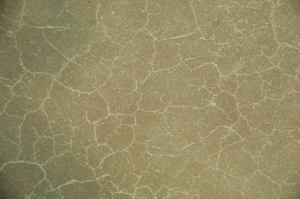CRAZE CRACKS
Q: We have been asked to restore a concrete slab, which has very fine and random cracks. They do not seem to be very deep and they are in a random pattern. Is this craze cracking, which I have heard about in the past? If so, why do they form and is there anything we can do to eliminate them?
A: The way you describe the surface, it does sound like crazing. Craze cracks are small pattern cracks on a slab’s surface. They are associated with early surface drying, causing the immediate surface to shrink differently than the underlying concrete. Crack patterns typically form grids of about 2-inch diameters. Craze cracks are very small and are found in the top surface of a slab. They are typically 1/10 millimeter (0.004 inches) or less in thickness, and 1 millimeter (1/32-inch ) or less in depth, according to Ron Strum, a petrographer for CTLGroup, Skokie, Ill. Many craze cracks are not even visible until the surface of a floor gets wet and starts to dry. Outside of appearance, they do not affect the performance of a slab.
Crazing is caused by drying out of the concrete surface, so it is particularly common when the surface has been exposed during placement to low humidity, high air or concrete temperature, hot sun, or any combination of these. Concrete contractors can minimize or prevent craze cracks by starting to cure as soon as possible after final finishing, especially on a hard-troweled floor. Moist curing is best, although a spray-on monomolecular curing compound also can be effective. Using a drier, stiffer mix can reduce crazing as well. For exterior slabs, minimize the amount of working or troweling of the surface and use a broomed finish, which tends to mask minor cracks and surface blemishes.
Craze cracking is only one of the types of cracks that occur due to shrinkage of the concrete. Others are plastic shrinkage cracks and drying shrinkage cracks. By definition, plastic shrinkage cracking occurs while the concrete is still plastic and typically while the slab is still being finished. These cracks are deeper and farther apart and also are caused by drying, as surface moisture evaporates. Synthetic fibers can help prevent plastic shrinkage cracking, as can fogging to reduce evaporation.
Drying shrinkage cracks occur after the slab has hardened and are due to the loss of moisture in the concrete matrix. Reduce drying shrinkage cracks by using lower water-cement ratio mixes. Control drying shrinkage cracks by properly placing joints in the slab—2 1/2 to 3 times in feet the thickness of the slab in inches (so 15 to 18 feet apart for a 6-inch slab).
So is there anything you can do with crazing after the fact? Not really. Typically, craze cracking is not repaired because it does not deteriorate over time. Sealers and surface hardeners actually can make crazing more obvious. If the owner really wants to fix crazing, a thin overlay is about the only choice.
Your Trusted Home Inspector
My name is John de Saint Georges and I own The Inspection Company LLC. I have been living in West Virginia for the last 10 years and have loved every minute of it. From the New and Greenbrier rivers and Snowshoe Mountain, this state has it all. I hope I can help you look over your new home here in the mountain state. I will let you know everything that you may need to know about your new home
Whether it’s a 1000-square-foot loft, a rambling country estate, or 6000-square-foot commercial building, I won’t rest until you’ve received my easy-to-read report and all of your questions have been answered.
The Inspection Company uses the latest home inspection software to deliver you a visual, modern home inspection report that explains our findings in a way you can understand.




